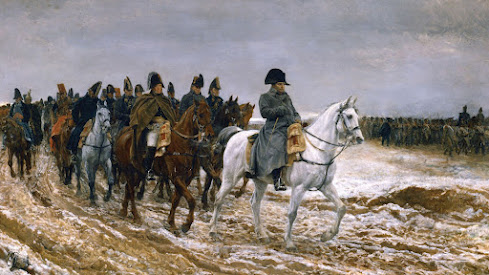Napoleons Russian Campaign
1812
On June 24th 1812, French Emperor Napoleon Bonaparte gathered the largest army ever assembled, 600,000 men, comprising 400,000 French and 200,000 allied soldiers from throughout Europe along with 1,200 guns and crossed the River Niemen into Russia.
Napoleon marched his army north of the Pripet marches threatening both St Petersburg and Moscow, hoping to destroy the Russian First Army under Prince Barclay de Tolly before it could link up with the Second Army under Prince Bagration farther south.
Almost immediately the Russians adopted a policy of strategic withdrawal and scorched earth, pulling Napoleon deeper into western Russia and more dependent on extremely tenuous supply lines made worse by the poor road system.
Marching ever eastward, Napoleon could not come to grips with the enemy and could do nothing to prevent a link up between Barclay and Bagration to the west of Smolensk in late July. A chance did occur when a sudden crossing of the Dnieper River caught the Russians by surprise.
But despite heavy fighting at Smolensk between August 17 - 19th, the outcome was indecisive and the Russians withdrew in good order. It was after this battle that Napoleon made the decision to advance on Moscow, a further 280 miles east.
After the battle of Smolensk, Russian Czar Alexander reorganized his command structure placing all Russian forces under Field Marshal Kutuzov with orders to defend the approaches to Moscow and halt the French invasion.
On August 29th Kutuzov assumed command of the Russian Army some 70 miles west of Moscow near the town of Borodino. Here the Russians prepared an elaborate series of defensive earthworks, redoubts and fleches to make there stand and awaited Napoleon.
After an epic march of 200 miles in 18 days the French began to arrive and take up positions. For the upcoming battle Napoleon would command 104,000 Infantry, 28,000 Cavalry and 600 Cannons. Kutuzov would counter with 97,000 Infantry, 24,000 Cavalry and 640 Cannons.
On the morning of September 7th Napoleon opened the battle with a series of flanking man oeuvre's against both the Russian left and right wings. In the north Eugene's 4th Corps captured the village of Borodino but a fierce Russian counter attack pushed the French back across the Koloch River, while In the south, Prince Ponitowski’s Polish Corps met with determined resistance and failed to secure Utitsa.
At 9:00 am with both enemy flanks holding firm, Napoleon turned his attention against the Russian center. After an extensive artillery bombardment Napoleon ordered a massed attack under Field Marshal Davout’s 4th and 10th Infantry divisions including General Junot’s 8th Corps supported by the 1st and 4th Cavalry Corps with orders to break the enemy center.
After bitter hand to hand fighting lasting the entire day the French succeeded in Capturing the Bagration Fleches and Great Redoubt. Kutuzov decided to pull back his forces a mile where he began to reorganize his shattered center.
A maneuver he was able to carry out unhindered when despite the urgent requests by several Generals and Marshals, Napoleon refused to commit his 20,000 strong Imperial Guard and perhaps finish the battle.
By nightfall the opposing army’s fell into a state of mutual exhaustion. Casualties on both sides had been extremely heavy. Russian losses were a staggering 45,000 among those were twenty three Generals of division. The French faired little better with 30,000 men lost including fourteen Generals.
Kutuzov had seen enough and decided to withdraw what remained of his army to the southwest, leaving the road to Moscow open. Napoleon carried on occupying the deserted city on September 14th, but it was a Pyrrhic victory made worse by a great fire which engulfed and destroyed much of the city.
As Napoleon remained in the city awaiting Czar Alexanders reply to his request to open peace negotiations, news reached the Emperor that Kutuzov was being reinforced and that other Russian forces were approaching Moscow in his support.
At this time Napoleon had only 100,000 operational troops left and the continued occupation of Moscow was becoming dangerous. Therefore on October 23rd in near freezing temperatures Napoleon ordered a withdrawal intending to fall back on supply depots at Smolensk and to prepare for a renewed campaign in 1813.
It was a disastrous move, the march exposed the Grand Army to the ravages of the Russian winter and the endless harassing attacks by partisans and mounted Cossack's. The French column more than fifty miles long quickly lost cohesion and on November 9th the lead elements went on a rampage of looting in Smolensk destroying nearly all the vital supplies.
On November 22nd Kutuzov’s army reached the Berezina River before Napoleon, trapping the French on the eastern bank. It would take all Napoleon’s tactical skill and military genius to force a crossing, after a week of intense fighting 40,000 French troops escaped however 50,000 were killed or captured.
By December 5th the French Grand Army virtually ceased to exist and Napoleon abandoned his shattered forces for the safety of Paris, leaving Marshal Murat to lead the remainder into the comparative safety of Poland.
On December 14th Marshal Ney ( reported to be the last Frenchman to leave Russian soil ) crossed the Polish border with the last of a mere 25,000 men remaining of the original 600,000 troops of the invasion force. It was a catastrophic defeat and marked the beginning of the end for Napoleons Empire.








No comments:
Post a Comment
Note: Only a member of this blog may post a comment.